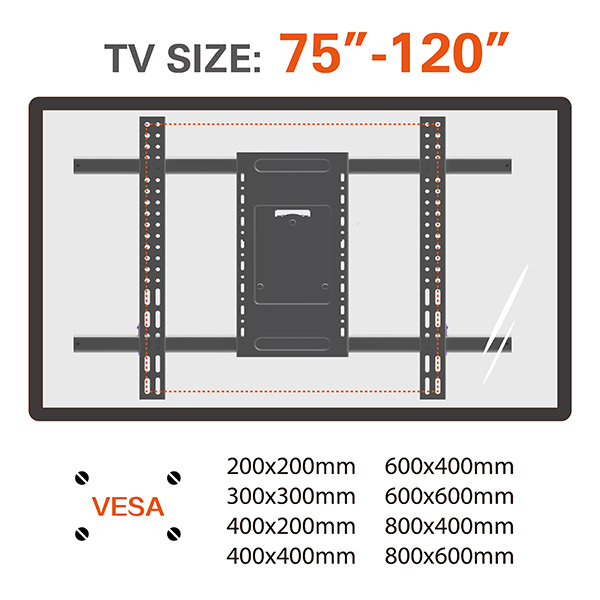Exploring VESA Mounts: Understanding the Significance and Benefits for Monitor mounts
Introduction:
In the world of monitors, the term "VESA mount" is frequently mentioned. But what exactly does it mean? VESA, short for Video Electronics Standards Association, is an organization that establishes standards for video and display-related technologies. A VESA mount refers to a standardized mounting interface that allows monitors to be securely attached to various mounting solutions, such as monitor arms, wall monitor mounts, or desk monitor mounts. In this comprehensive article, we will delve into the topic of VESA mounts, discussing their significance, benefits, and the factors to consider when selecting a VESA-compatible monitor. By the end, you will have a thorough understanding of VESA mounts and their role in optimizing your monitor setup.
Table of Contents:
What is a VESA Mount?
a.Introduction to the Video Electronics Standards Association (VESA)
A VESA mount for a monitor refers to a standardized mounting interface that allows the monitor to be securely attached to various mounting solutions, such as monitor arms, wall mounts, or desk mounts. VESA, which stands for Video Electronics Standards Association, is an organization that establishes standards for video and display-related technologies.
The VESA mount consists of a pattern of mounting holes on the back of the monitor, which corresponds to a specific VESA standard. These mounting holes are arranged in a square or rectangular pattern and are measured in millimeters. The most common VESA mount standards are VESA 75x75 (75mm x 75mm hole pattern) and VESA 100x100 (100mm x 100mm hole pattern), but there are also other variations available.
b.Definition and purpose of a VESA mount
The purpose of the VESA monitor mount is to provide a universal mounting solution that allows monitors to be easily and securely attached to compatible mounting arms, stands, or brackets. By adhering to VESA standards, monitor manufacturers ensure that their products can be used with a wide range of mounting options available in the market.
c.The evolution of VESA mounting standards
Early Days of VESA: In the early 1980s, VESA was established as an industry association to develop and promote standards for video and display-related technologies. The initial focus was on establishing interoperability standards for graphics cards and monitors.
Introduction of VESA Flat Display Mounting Interface (FDMI): The VESA Flat Display Mounting Interface (FDMI) standard, also known as VESA mount, was introduced in the mid-1990s. It defined the mounting hole patterns on the back of displays to ensure compatibility with mounting arms, brackets, and other mounting solutions.
VESA 75x75 and VESA 100x100: The most commonly used VESA standards, VESA 75x75 and VESA 100x100, emerged as the industry standards for smaller-sized monitors. These standards specified the hole patterns and measurements (in millimeters) for the mounting holes on the back of the monitors.
Expansion of VESA Mount Sizes: As larger and heavier monitors became prevalent, the VESA standards expanded to accommodate them. This led to the introduction of VESA 200x100, VESA 200x200, and other larger VESA mount sizes to support bigger displays.
Introduction of VESA DisplayPort Mounting Interface (DPMS): With the increasing popularity of DisplayPort as a digital display interface, VESA introduced the VESA DisplayPort Mounting Interface (DPMS) standard. DPMS enabled the integration of DisplayPort cables into VESA mounts, providing a streamlined and clutter-free setup.
VESA 400x400 and Beyond: As displays continued to grow in size, VESA standards expanded further to accommodate larger and heavier monitors. VESA 400x400, VESA 600x400, and other larger mount sizes were introduced to support the growing demand for high-resolution, large-scale displays.
VESA Adaptive-Sync and Mounting Standards: VESA also played a significant role in the development and promotion of technologies like VESA Adaptive-Sync, which provides variable refresh rates for smoother gaming experiences. Alongside these advancements, VESA continued to refine and update the mounting standards to ensure compatibility with new display technologies and emerging form factors.
Constant Refinement and Future Trends: VESA continues to refine and update the mounting standards to keep pace with the evolving display technologies and market demands. As new form factors, such as curved displays, ultra-wide monitors, and virtual reality headsets, gain popularity, VESA is likely to adapt the mounting standards to accommodate these emerging display types.
Why VESA Mounts Matter
a. Flexibility and ergonomic advantages of monitor mounting
b. Space optimization and decluttering benefits
c. Enhancing viewing comfort and reducing strain
Understanding VESA Mount Standards
a. VESA hole pattern measurements and configurations
b. Common VESA mount standards (e.g., VESA 75x75, VESA 100x100)
c. Exploring variations and compatibility considerations
Choosing a VESA-Compatible Monitor
a. Importance of VESA compatibility when purchasing a monitor
b. Checking VESA mount specifications and options
c. Finding the right VESA mount size for your monitor
Types of VESA Mounting Solutions
a. Monitor arms and desk mounts
b. Wall mounts and articulating arms
c. Monitor stands with integrated VESA mounts
Installing a VESA Mount
a. Preparing your workspace and tools
b. Step-by-step guide for mounting a monitor
c. Tips for cable management and adjustment
Benefits of VESA Mounts in Different Environments
a. Home office setups and productivity enhancement
b. Gaming and immersive experiences
c. Collaborative and multi-monitor configurations
VESA Mount Maintenance and Troubleshooting
a. Cleaning and maintaining VESA mounts
b. Common issues and troubleshooting tips
c. Seeking professional assistance when needed
VESA Mount Alternatives and Future Trends
a. Non-VESA mounting solutions and adapters
b. Emerging trends in monitor mounting technologies
c. The future of VESA mounts and evolving standards
Conclusion :
VESA mounts have revolutionized the way we interact with monitors, providing flexibility, ergonomics, and space optimization in various environments. By understanding the significance and benefits of VESA mounts, as well as the considerations when selecting and installing a VESA-compatible monitor, you can create a customized an6d comfortable viewing experience. Whether you are setting up a home office, gaming station, or collaborative workspace, VESA mounts offer the versatility to adapt and enhance your monitor setup. Embrace the possibilities of VESA mounts, and unlock the full potential of your monitor in terms of productivity, comfort, and overall visual enjoyment./
Post time: Nov-10-2023





